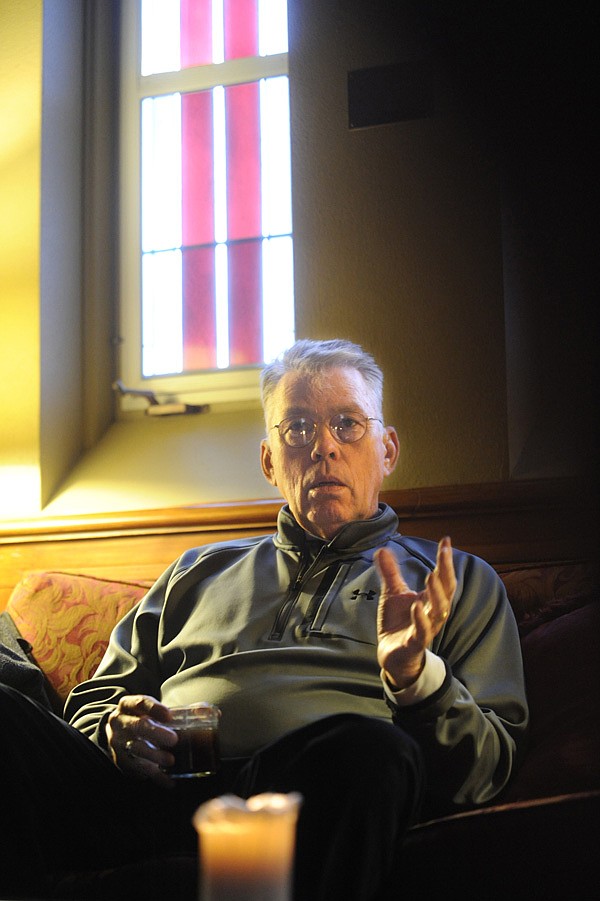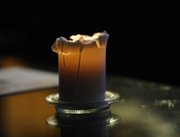CHRISTIAN MEDITATION: Stillness Within
CENTERING PRAYER DEEPENS RELATIONSHIP WITH GOD
Saturday, January 14, 2012
FAYETTEVILLE — The clear sound of a gong reverberates through the room.
Once. Twice. Three times.
Participants in the centering prayer session sit with their eyes closed, feet flat on the floor. Their hands rest gently in their laps. They’ll stay this way for the next 20 minutes, entering the “inner room” of prayer Jesus alluded to in Matthew 6:6.
The ticking of a wall clock is noticeable in the silence. So is the sound of traffic on the wet street outside. An interior dialogue rises to the surface. Thoughts, feelings and images chase one another through the mind.
The aim of the practice is to become aware of this constantly shifting panorama of thoughts and return - “ever so gently,” practitioners say - to a place of interior stillness. Participants use a special word or symbol to refocus their minds.
The word is not repeated over and over like a mantra, explains group leader Nick Cole. Instead, it serves as a reminder, shifting one’s attention from the fl ow of thoughts.
“When I find myself thinking, I say the sacred word. It’s an arrow pointing me back to the center.”
This is centering prayer, a form of Christian meditation introduced by Trappist monks in the 1970s. The practice has roots in the ancient Christian tradition of contemplative prayer, Cole said. This was a prayer form favored by the desert monastics of the third through sixth centuries.
Centering prayer is not synonymous with contemplative prayer - a deep “resting in God” - but ofters a method for preparing one to receive that gift, Cole said.
“The goal is to develop and foster an ongoing, deepening relationship with God.”
Cole leads several ongoing centering prayer support groups at St. Paul’s Episcopal Church in Fayetteville.
Participants begin with 20 minutes of the silent prayer. Then they watch a 30-minute DVD discussing some aspect of the prayer or the psychological framework which supports it. The remainder of the 90-minute session is spent talking about the DVD or their experiences with the prayer.
A TRANSFORMING PRACTICE
Thomas Keating, former abbot of St. Joseph’s Abbey in Spencer, Mass., developed the prayer form in response to the spiritual hunger he saw in young people in the 1960s and ’70s, Cole said.
Young Catholics were leaving the church to embrace Eastern spirituality and meditation.
Keating wanted them to know there was a viable form of meditation within their own tradition, Cole said. He began oftering centering prayer workshops and retreats. In 1981, Keating retired and moved to St. Benedict’s Monastery in Snowmass, Colo., where he continues to ofter monthly centering prayer retreats.
“The source of Centering Prayer is the Indwelling Trinity. Its practice consists of responding to the call of the Holy Spirit to consent to the Divine presence and action within.”
CONTEMPLATIVE OUTREACH THEOLOGICAL PRINCIPLE NO. 4
Contemplative Outreach, a spiritual network formed in the early 1980s, supports more than 120 chapters and 800prayer groups in 39 countries. People of all ages and many denominations take part, Cole said.
Cole attended his first retreat at Snowmass in 1990.
“I had no idea what I was getting into,” he said. “It was intimidating. I had no background in meditation. But the timing was right for me. I was ready for that particular practice. I took it one 20-minute session at a time.”
Twenty-one years later, Cole is still praying. The practice has transformed his life, he said. He was 48 years old when he started, struggling to reconcile a fairly successful life with the discontent he felt inside.
The process of turning within allows “the divine physician” to do his work, Keating teaches. It transforms the long-held structures of thought that keep people from a connection with God.
Keating developed a sophisticated framework for understanding how the human psyche operates, Cole said. The support groups will begin a new series of DVDs this week exploring what Keating terms “the human condition” and how to transform it.
FRUITS OF THE SPIRIT
It’s easier to say what centering prayer is not - arelaxation exercise, a form of self-hypnosis, a charismatic gift or an experience of felt or reflective prayer - than what it is, Cole said.
AT A GLANCE
CENTERING PRAYER RESOURCES
Open Support Group
Meets: 7 p.m. Tuesdays; 8:30 a.m. Wednesdays
Where: St. Paul’s Episcopal Church library, 224 N. East Ave., Fayetteville Daily Sitting Prayer
Time: 8:30 a.m and 4 p.m. Monday-Friday
Where: St. Paul’s Episcopal Church library, 224 N. East Ave., Fayetteville Centering Prayer Retreat
Date: March 23-25
Place: St. Scholastica Retreat Center in Fort Smith
Information: Contact Nick Cole at [email protected] or 970-275-1170
or view the Contemplative Outreach website at
www.centeringprayer.com SOURCE: STAFF REPORT
“It’s a prayer of subtraction rather than addition. It’s all about letting go of what is between me and God.”
The goal is not to stop the constant fl ow of thoughts in the mind but to become aware of the process of thinking, hesaid. This unattached noticing makes room for a deeper awareness of God, practitioners say.
The recommended amount of time for centering prayer is 20 minutes twice a day.
There is no desired or preferred outcome to a centering prayer session, Cole said. A time of distraction or barrenness is as good as a time of insight or peace. Theonly way to judge the eff ect of the prayer is by looking at “the fruits of the spirit” in daily life, he said.
The Rev. Lowell Grisham, who also teaches centering prayer, said his wife, Kathy, flagged the effects in him before he did.
“Are you still doing that prayer you told me about?” she asked. “Keep it up. You’re a little easier to live with these days.”
Grisham was introduced to centering prayer in seminary - and “absolutely hated it,” he said. “It made me nervous and itchy.” Yet when he tried it again in mid-life he had a diff erent experience.
“I could sit in silence for 20 minutes. I was not so distracted and distressed,” he said. “And I noticed some reservoir of peace andspaciousness it seemed to leave me.”
The practice of centering prayer has taught him to pause between stimulus and response, he said.
“When something unsettling happens, instead of immediate reaction, there is some space. It helps me wait,”he said. “In that way, I can find a wisdom and patience.”
No one form of prayer works for everyone, Grisham cautioned. Those interested in centering prayer must commit to it long enough to see if it works for them.
Community members are welcome to join Cole’s groups or the ongoing sitting prayer group that meets at St. Paul’s twice a day.
Cole will lead a centering prayer retreat at St. Scholastica Retreat Center in Fort Smith in March.
He has led retreats at Snowmass since 1993.
Religion, Pages 8 on 01/14/2012

